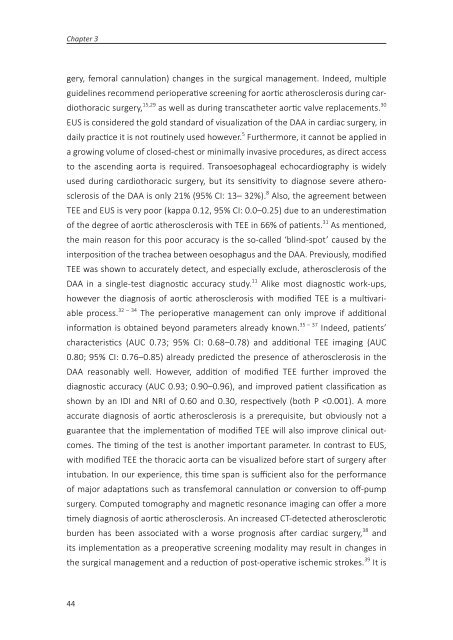Proefschrift Jansen Klomp
Create successful ePaper yourself
Turn your PDF publications into a flip-book with our unique Google optimized e-Paper software.
Chapter 3<br />
gery, femoral cannulation) changes in the surgical management. Indeed, multiple<br />
guidelines recommend perioperative screening for aortic atherosclerosis during cardiothoracic<br />
surgery, 15,29 as well as during transcatheter aortic valve replacements. 30<br />
EUS is considered the gold standard of visualization of the DAA in cardiac surgery, in<br />
daily practice it is not routinely used however. 5 Furthermore, it cannot be applied in<br />
a growing volume of closed-chest or minimally invasive procedures, as direct access<br />
to the ascending aorta is required. Transoesophageal echocardiography is widely<br />
used during cardiothoracic surgery, but its sensitivity to diagnose severe atherosclerosis<br />
of the DAA is only 21% (95% CI: 13– 32%). 8 Also, the agreement between<br />
TEE and EUS is very poor (kappa 0.12, 95% CI: 0.0–0.25) due to an underestimation<br />
of the degree of aortic atherosclerosis with TEE in 66% of patients. 31 As mentioned,<br />
the main reason for this poor accuracy is the so-called ‘blind-spot’ caused by the<br />
interposition of the trachea between oesophagus and the DAA. Previously, modified<br />
TEE was shown to accurately detect, and especially exclude, atherosclerosis of the<br />
DAA in a single-test diagnostic accuracy study. 11 Alike most diagnostic work-ups,<br />
however the diagnosis of aortic atherosclerosis with modified TEE is a multivariable<br />
process. 32 – 34 The perioperative management can only improve if additional<br />
information is obtained beyond parameters already known. 35 – 37 Indeed, patients’<br />
characteristics (AUC 0.73; 95% CI: 0.68–0.78) and additional TEE imaging (AUC<br />
0.80; 95% CI: 0.76–0.85) already predicted the presence of atherosclerosis in the<br />
DAA reasonably well. However, addition of modified TEE further improved the<br />
diagnostic accuracy (AUC 0.93; 0.90–0.96), and improved patient classification as<br />
shown by an IDI and NRI of 0.60 and 0.30, respectively (both P


